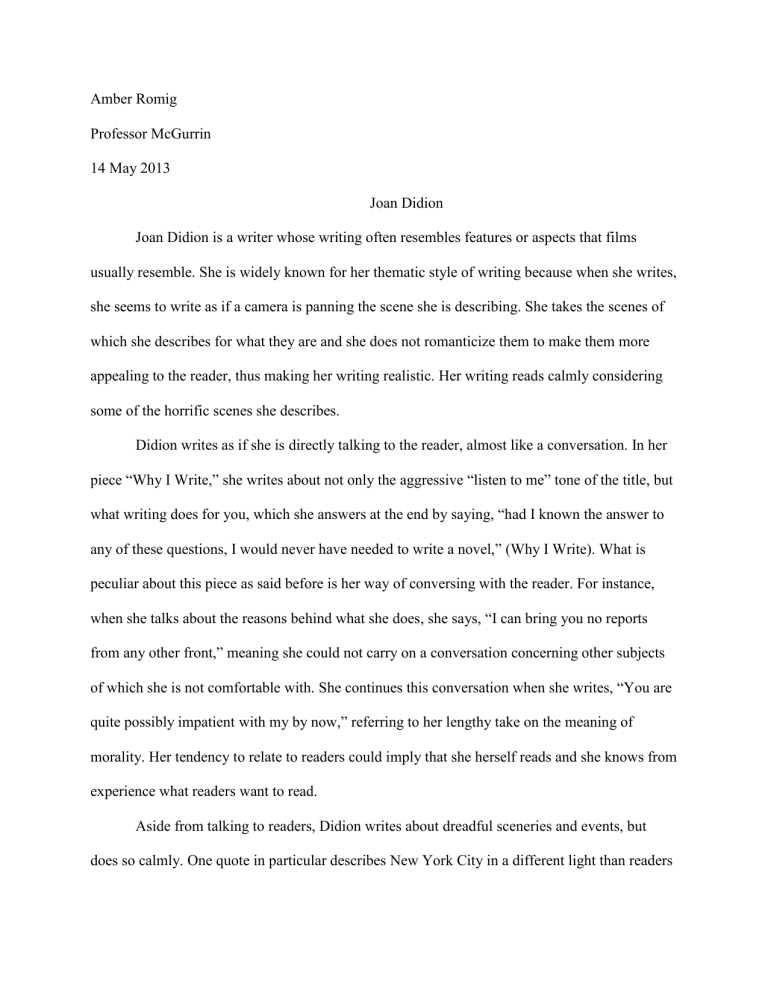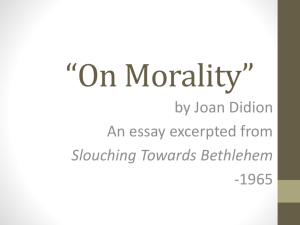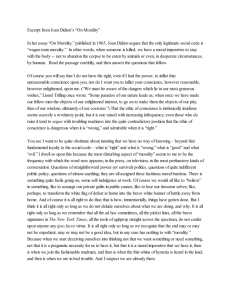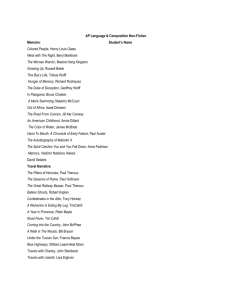Joan Didion - StudentFreelance.com

Amber Romig
Professor McGurrin
14 May 2013
Joan Didion
Joan Didion is a writer whose writing often resembles features or aspects that films usually resemble. She is widely known for her thematic style of writing because when she writes, she seems to write as if a camera is panning the scene she is describing. She takes the scenes of which she describes for what they are and she does not romanticize them to make them more appealing to the reader, thus making her writing realistic. Her writing reads calmly considering some of the horrific scenes she describes.
Didion writes as if she is directly talking to the reader, almost like a conversation. In her piece “Why I Write,” she writes about not only the aggressive “listen to me” tone of the title, but what writing does for you, which she answers at the end by saying, “had I known the answer to any of these questions, I would never have needed to write a novel,” (Why I Write). What is peculiar about this piece as said before is her way of conversing with the reader. For instance, when she talks about the reasons behind what she does, she says, “I can bring you no reports from any other front,” meaning she could not carry on a conversation concerning other subjects of which she is not comfortable with. She continues this conversation when she writes, “You are quite possibly impatient with my by now,” referring to her lengthy take on the meaning of morality. Her tendency to relate to readers could imply that she herself reads and she knows from experience what readers want to read.
Aside from talking to readers, Didion writes about dreadful sceneries and events, but does so calmly. One quote in particular describes New York City in a different light than readers
are used to. In “Goodbye To All That,” Didion writes, “That first night I opened my window on the bus into town and watched for the skyline, but all I could see were the wastes of Queens,”
(Goodbye To All That). Readers are used to reading glamorous descriptions of New York City because it is the city that never sleeps, a city that offers luxuries like Broadway and high end shopping; however, Didion describes a city that appears to be run down from always being awake. She shows the effects on a city that is constantly being used by tons of people. In films like William Wyler’s “Funny Girl” and John Badham’s Saturday Night Fever, viewers see New
York City as a place where people can become big stars or a place filled with opportunity. This can even be seen in the film “Across the Universe” directed by Julie Taymor. Even though the situation may not be ideal, the characters want to go to New York to make it into the music business. With media showing New York as a glamorous city where all your dreams can come true, it is admirable that Didion is not afraid to go against society’s norms to reveal the truths of the human world.
Going along with the previous quote, Didion shows her ability to pan the “camera” for readers to be able to envision the scene being describes. After seeing the “wastes of Queens,”
Didion continues on and writes that she then saw, “big signs that said MIDTOWN TUNNEL
THIS LANE and then a flood of summer rain (even that seemed remarkable and exotic, for I had come out of the West where there was no summer rain), and for the next three days I sat wrapped in blankets in a hotel room air conditioned to 35 degrees and tried to get over a cold and a high fever,” (Goodbye To All That). Didion hopes for the best, but one bad thing after another occurs.
It is interesting that Didion does not dwell on one specific event. She continues writing which represents life in a way because life keeps going or happening without stopping.
Another instance of Didion panning the camera can be found in “On Morality” when
Didion writes, “As it happens I am in Death Valley, in a room at the Enterprise Motel and Trailer
Park, and it is July, and it is hot. In fact it is 119°. I cannot seem to make the air conditioner work, but there is a small refrigerator, and I can wrap ice cubes in a towel and hold them against the small of my back.” In this paragraph alone, Didion describes a chain of events so smoothly without making her words and sentences seem awkward or choppy. This style of writing compares to Arthur Miller’s play “Death of a Salesman.” A specific instance is as follows:
“WILLY
(after a pause)
: I suddenly couldn’t drive any more. The car kept going off onto the shoulder, y’know?
LINDA (helpfully) : Oh. Maybe it was the steering again.
WILLY: No, it’s me, it’s me. Suddenly I realize I’m goin’ sixty milesan hour and I don’t remember the last five minutes.”
In other words, Willy describes what happens on his way home from work in chronological order as a play should. E.B. White can be seen referring to panning the camera in “Once More to the
Lake” as well when he writes, ““You remember one thing, and that suddenly reminds you of another thing,” (Once More to the Lake). Although Didion’s style is not exactly reflected in
White’s essay, readers can get a similar feel and understanding that not only does life keep going, but so do thoughts or senses that are attached to memories.
Didion uses great descriptive words as well when describing her surroundings. For instance, in “Goodbye To All That,” Didion writes, “the Seagram Building fountains dissolve into snowflakes.” It is interesting that Didion focuses on the fountains by the Seagram Building rather than the building itself because the building is a well known skyscraper, yet the water is the focus. Didion describes the water as dissolving snowflakes which is an interesting
comparison because snowflakes are groups of ice crystals, so her descriptions could suggest the water is cold. Or perhaps the water coming together and then splitting at the top of the fountain resembles a snowflake. An interesting thing about Didion’s writing is that she leaves so much room for readers to make their own interpretations.
While Didion describes complex sceneries with ease, she seems to focus on sight rather than the other senses. In “On Going Home,” Didion talks about waiting for her husband to call and while she waits, she visits her family’s graveyard. She writes, “It has been vandalized since my last visit and the monuments are broken, overturned in the dry grass,” (On Going Home).
While a graveyard is not necessarily a place of many smells or sounds, Didion could appeal to these senses to give the reader a feel for the graveyard. Was it especially quiet or was life still happening (i.e. birds, airplanes, etc.)? In E.B. White’s “Once More to the Lake,” White does what Didion does not and gives the reader a full sense of his environment. He says he,
“remembered how the bedroom smelled of the lumber it was made of and of the wet woods whose scent entered through the screen.” By explaining to the reader how he felt at the lake, the reader can feel as if they are actually in the lake house. Didion’s style is more like painting a picture. She describes her experiences visually.
Besides her descriptive language, Didion shows off her sophistication or rather her well educated background with her use of language, particularly her vocabulary. For example, she says, “I dwell so upon this because the most disturbing aspect of “morality” seems to me to be the frequency with which the word now appears; in the press, on television, in the most perfunctory kinds of conversation,” (On Morality). Didion’s writing is not composed of simple vocabulary words making her work geared towards those who have been educated enough to be
able to understand what she is trying to convey. The words she chooses to use in her sentences force readers to think about the meaning behind said words.
Another piece that Didion writes is entitled “On Going Home,” a piece about the differences between her and her husband’s way of life and her family’s life. Compared to her other writing, “On Going Home” seems to reflect Didion’s feelings a bit more, most likely due to the topic being tremendously personal for Didion. First of all, when talking about marriage possibly being a failure, Didion writes, “Sometimes, I think that those of us who are now in our thirties were born into the last generation to carry the burden of “home,” to find in family life the source of all tension and drama. I had by all objective accounts a “normal” and a “happy” family situation, and yet I was almost thirty years old before I could talk to my family on the telephone without crying after I had hung up,” (On Going Home). This is a strange way of going about the situation at hand for Didion because Didion’s style is panning the camera and not dwelling on any one event; however, when Didion begins to talk about her struggle with her family, it seems like it is a struggle she has not let go of yet. She is dwelling on the hurt that she feels, especially when she mentions that she just recently stopped crying after talking on the phone with her family.
Didion also uses juxtaposition in her writing. For instance, in “On Morality,” Didion says that Alfred Rosenberg used morality to justify his role with the Nazi’s in Germany, but later on,
Didion says Jesus used morality to justify his good deeds. She writes, “Klaus Fuchs said it, and the men who committed the Mountain Meadows Massacre said it, and Alfred Rosenberg said it.
And, as we are rotely and rather presumptuously reminded by those who would say it now, Jesus said it,” (On Morality). By putting these two seemingly opposite examples next to each other,
Didion suggests that virtually anyone can use morality to justify their actions regardless of if
they are “bad” or “good.” Furthermore, Didion’s argument can relate to September 11 th
attacks in New York City. Osama Bin Laden and his people thought that they were carrying out a task for their god, so for them, they were being moral by following through on their beliefs; however,
Americans felt vulnerable because someone wanted to cause harm upon their people. They saw the act as immoral. That being said, morality may be a concept that people use on their own terms, suggesting that the definition of morality is not universal.
To conclude, Joan Didion is an author who uses a wide variety of unique writing techniques, separating herself from other authors. She is able to describe the scenes she experiences without spending too much time on any detail, relating her style to a film. Her arguments may be difficult to agree with, especially in “On Morality;” however, she is able to fully support her argument to ensure her readers understand her side completely before passing judgment. All in all, Didion is a phenomenal essayist who deserves more attention and respect than she receives.





